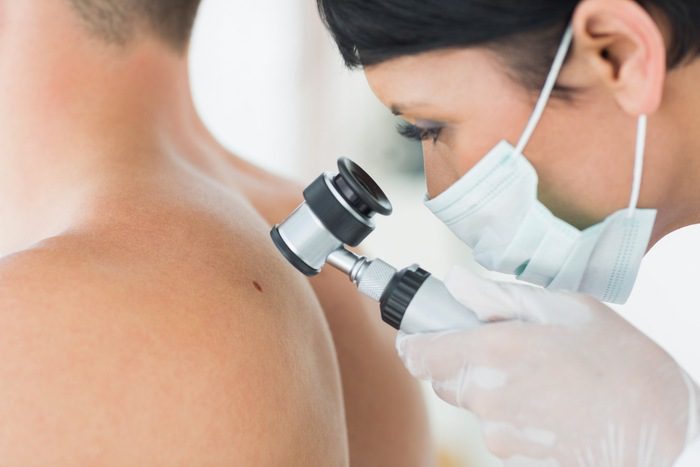Skin cancer is one of the most common types of cancer. We differentiate white skin and black skin cancer, with white being the less aggressive of the two. Around 75% of skin cancer occur after the age of 50. It should be imperative that you check yourself every once and again and if you notice any irregularities, consult a doctor. The irregularities could be new spots or bumps on the body which don’t look normal. The sooner you get it checked, the sooner it can get surgically removed!
To educate yourself further on this matter, continue reading the article from Dr. Andrea Garbea.
In three quarters of all cases, skin cancer occurs after the age of 50. Along with breast and lung cancer, it is one of the most common types of cancer. A distinction is made between white skin cancer (spinalioma, basalioma) and black skin cancer (melanoma). White skin cancer accounts for 90 percent of all skin cancer cases. Compared to the less common black skin cancer, light skin cancers are much less aggressive. Melanoma, however, can take an aggressive course and form metastases that can attack other tissue. Fortunately, trained patients can recognise these visible skin changes themselves with the naked eye. So by regularly checking the skin, the danger can be largely contained. How can skin cancer be detected? What forms does it take? What treatment options are there? Dr. Andrea Garbea, Dermatologist in Lutry, provides advice and answers to avoid feeling queasy.
What does skin cancer look like?
A distinction must be made between white and black skin cancer. The former also called non-melanocytic skin cancer, is the most widespread form. Worldwide, about 2 to 3 million cases occur every year. Melanocytic skin cancer or melanoma is more dangerous, but much rarer. White skin cancer usually develops very slowly. It often manifests itself in the form of indurated bumps. The nodules are often reddish and can be crusted, rough and bumpy and bleed easily. In black skin cancer, the skin lesions are often dark to black, vary in pigmentation and grow faster. They can become significantly larger in just a few months.
The lesions are recognised with the help of the ABCD rule:
A for asymmetry: the spots are not round but misshapen.
B for boundary: the edges of the spots are irregular, jagged.
C for color: they are of different colors and blotches.
D for dynamic: shape, color, size and thickness change and they are usually more than half a centimeter in size.
If these criteria are met, it is essential to consult a doctor.
How can you detect skin cancer yourself? What do you have to watch out for?
The first rule is to regularly examine the skin yourself. After the age of 50, changes must be observed particularly closely. In fact, this is the first step of treatment. Many patients come to me because they have noticed a new spot when looking over their shoulder. However, these are often normal age spots, which are often symmetrical, round and homogeneous. Skin cancer is not “natural”, so the spots are asymmetrical and misshapen. In some areas of the body, for example on the back, a small mirror is recommended to check the skin. The advantage of skin cancer is that it is visible and abnormalities can actually be detected.
Are some areas of skin more sensitive than others?
In general, all areas exposed to the sun are at risk. In most cases of white skin cancer, the hands, décolleté, neck, face, nose and scalp are particularly affected when there is no or hardly any hair. The famous “driver’s skin cancer” really exists. Some patients who drive a lot have lesions all over the left side of their face or left arm because of the sun shining through the window into the vehicle.
What are the risk factors?
The main risk factor is overexposure to the sun during life, with or without sunburn. Sun sensitivity is also strongly linked to skin type. In terms of sun sensitivity, there are six phototypes, from very light skin to dark skin to black skin. People with skin types I and II have very light skin that almost never tans and burns quickly in the sun. They are particularly susceptible to UV rays. Sunburn significantly increases the risk of skin cancer. Skin types V and VI, i.e. dark and black, have the lowest risk of sunburn. Certain carcinogenic substances such as arsenic, tar and unrefined mineral oils also increase the risk. The same applies to certain medications such as immunosuppressants, X-rays and gamma rays. Genetic factors also play a role; if parents or siblings have had skin cancer, special caution is advised. And finally, people with many moles on their body, for example, more than 50, also belong to the risk group. Approximately 20 % of melanomas develop on an existing birthmark.
What are the treatments?
The most common treatment for white skin cancer is surgical removal. After local anesthesia, the skin cancer is removed with a safety margin, then the wound is sutured. The procedure is often performed on an outpatient basis, directly in the doctor’s office. Hospitalisation is only necessary if large areas of skin are affected. For superficial lesions, cryotherapy (therapy with cold) can also be used. The affected skin area is iced with liquid nitrogen.
If surgery would be too risky, for example in the corner of the eye, radiotherapy can also be used. Another solution is creams that modulate the immune system. Or photodynamic therapy, in which a photosensitising cream is applied. The area is then irradiated with light of a suitable wavelength, which destroys the cancer cells. In the case of black cancer, the affected areas of skin are surgically removed with a safety margin.
If necessary, chemotherapy, radiotherapy or immunotherapy will follow.
What preventive tips do you have to prevent this from happening in the first place?
If you have already had skin cancer, regular check-ups with your doctor are necessary to avoid a recurrence, i.e. a new disease. As already mentioned, self-examination is also very important. In addition, one must protect oneself from the sun and avoid sunburn at all costs. Between 11 a.m. and 3 p.m., when the sun is most aggressive, you should especially avoid it and dress accordingly: Blouse or shirt with long sleeves, hat and sunglasses. Areas that cannot be protected by clothing should be covered with sunscreen with a high sun protection factor, such as the face, neck, ears, neck and hands. If you have had frequent sunburns in your life, you should also take special care from the age of 50.
Interview by Jean-Baptiste Bourgeon










